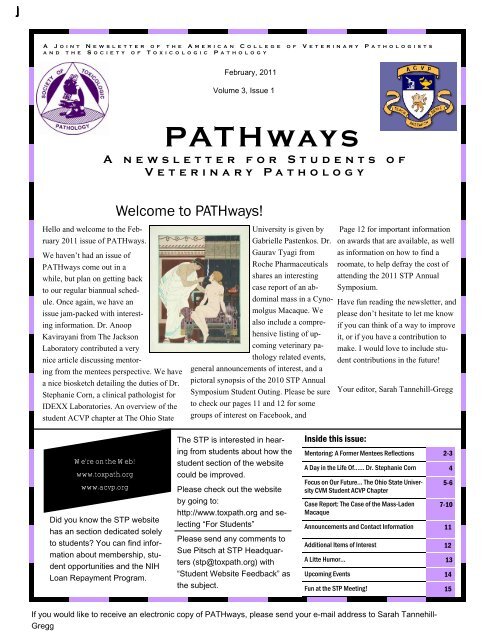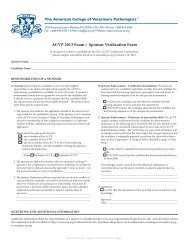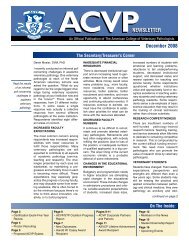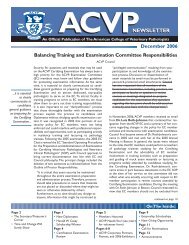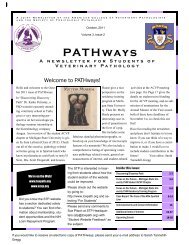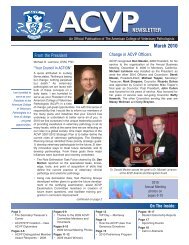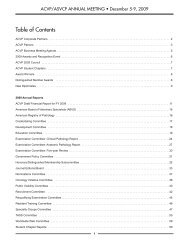PATHways - American College of Veterinary Pathologists
PATHways - American College of Veterinary Pathologists
PATHways - American College of Veterinary Pathologists
You also want an ePaper? Increase the reach of your titles
YUMPU automatically turns print PDFs into web optimized ePapers that Google loves.
A J O I N T N E W S L E T T E R O F T H E A M E R I C A N C O L L E G E O F V E T E R I N A R Y P A T H O L O G I S T S<br />
A N D T H E S O C I E T Y O F T O X I C O L O G I C P A T H O L O G Y<br />
Hello and welcome to the February<br />
2011 issue <strong>of</strong> <strong>PATHways</strong>.<br />
We haven’t had an issue <strong>of</strong><br />
<strong>PATHways</strong> come out in a<br />
while, but plan on getting back<br />
to our regular biannual schedule.<br />
Once again, we have an<br />
issue jam-packed with interesting<br />
information. Dr. Anoop<br />
Kavirayani from The Jackson<br />
Laboratory contributed a very<br />
nice article discussing mentoring<br />
from the mentees perspective. We have<br />
a nice biosketch detailing the duties <strong>of</strong> Dr.<br />
Stephanie Corn, a clinical pathologist for<br />
IDEXX Laboratories. An overview <strong>of</strong> the<br />
student ACVP chapter at The Ohio State<br />
February, 2011<br />
Volume 3, Issue 1<br />
<strong>PATHways</strong><br />
A newsletter for Students <strong>of</strong><br />
<strong>Veterinary</strong> Pathology<br />
We’re on the Web!<br />
www.toxpath.org<br />
www.acvp.org<br />
Did you know the STP website<br />
has an section dedicated solely<br />
to students? You can find information<br />
about membership, student<br />
opportunities and the NIH<br />
Loan Repayment Program.<br />
Welcome to <strong>PATHways</strong>!<br />
University is given by<br />
Gabrielle Pastenkos. Dr.<br />
Gaurav Tyagi from<br />
Roche Pharmaceuticals<br />
shares an interesting<br />
case report <strong>of</strong> an abdominal<br />
mass in a Cynomolgus<br />
Macaque. We<br />
also include a comprehensive<br />
listing <strong>of</strong> upcoming<br />
veterinary pathology<br />
related events,<br />
general announcements <strong>of</strong> interest, and a<br />
pictoral synopsis <strong>of</strong> the 2010 STP Annual<br />
Symposium Student Outing. Please be sure<br />
to check our pages 11 and 12 for some<br />
groups <strong>of</strong> interest on Facebook, and<br />
The STP is interested in hearing<br />
from students about how the<br />
student section <strong>of</strong> the website<br />
could be improved.<br />
Please check out the website<br />
by going to:<br />
http://www.toxpath.org and selecting<br />
“For Students”<br />
Please send any comments to<br />
Sue Pitsch at STP Headquarters<br />
(stp@toxpath.org) with<br />
“Student Website Feedback” as<br />
the subject.<br />
Inside this issue:<br />
Page 12 for important information<br />
on awards that are available, as well<br />
as information on how to find a<br />
roomate, to help defray the cost <strong>of</strong><br />
attending the 2011 STP Annual<br />
Symposium.<br />
Have fun reading the newsletter, and<br />
please don’t hesitate to let me know<br />
if you can think <strong>of</strong> a way to improve<br />
it, or if you have a contribution to<br />
make. I would love to include student<br />
contributions in the future!<br />
Your editor, Sarah Tannehill-Gregg<br />
Mentoring: A Former Mentees Reflections 2-3<br />
A Day in the Life Of…… Dr. Stephanie Corn 4<br />
Focus on Our Future… The Ohio State University<br />
CVM Student ACVP Chapter<br />
Case Report: The Case <strong>of</strong> the Mass-Laden<br />
Macaque<br />
5-6<br />
7-10<br />
Announcements and Contact Information 11<br />
Additional Items <strong>of</strong> Interest 12<br />
A Litte Humor... 13<br />
Upcoming Events 14<br />
Fun at the STP Meeting! 15<br />
If you would like to receive an electronic copy <strong>of</strong> <strong>PATHways</strong>, please send your e-mail address to Sarah Tannehill-<br />
Gregg
Volume 3, Issue 1 Page 2<br />
Mentoring: A former mentee’s reflections<br />
Contributed by Dr. Anoop Kavirayani, The Jackson Laboratory, Bar Harbor, Maine<br />
The teacher is the prior form, the taught is the posterior<br />
form, learning is the intermediate form and<br />
knowledge is the connection. Thus one should meditate<br />
upon knowledge. (The Upanishads)<br />
Mentoring can be thought <strong>of</strong> as an augmentation <strong>of</strong><br />
the learning process that results in the enrichment <strong>of</strong> a<br />
mentee’s knowledge in that discipline or pursuit. The<br />
mentee and mentor are integral components <strong>of</strong> such a<br />
mentoring equation that consists <strong>of</strong> dynamic impartation<br />
and imbibition <strong>of</strong> skill sets necessary for success<br />
in pr<strong>of</strong>essional practice.<br />
In more specific terms, the Oxford Dictionary <strong>of</strong> Human<br />
Resource Management (© Oxford University<br />
Press, 2010) defines mentoring as “the process,<br />
whereby a senior employee takes an active role in<br />
developing a junior colleague. Typically, this occurs<br />
at managerial level or amongst pr<strong>of</strong>essions. The mentor<br />
provides advice on how the mentee can develop<br />
his or her skills, competencies, knowledge, and experience<br />
in order to progress along a successful career<br />
path. As well as giving advice, the mentor might<br />
also prove useful in providing contacts that help the<br />
mentee to engage in the process <strong>of</strong> networking.”<br />
This definition seems to readily apply to Pathology<br />
training programs in which practicing <strong>Pathologists</strong><br />
and Pathology educators facilitate in various ways,<br />
the favorable metamorphosis <strong>of</strong> students to <strong>Pathologists</strong><br />
through the critical stage <strong>of</strong> residency.<br />
With the above perspective, it seems appropriate to<br />
reflect on the mentee side <strong>of</strong> the equation as applicable<br />
to Pathology mentoring. Once students transform<br />
to residents, they typically become units <strong>of</strong> a smaller,<br />
much more interconnected training group in which<br />
timed lectures and tailored laboratory sessions are no<br />
longer staples, but vital supplements. Instruction in<br />
Pathology as it happens becomes the staple.<br />
Mentees can make the most <strong>of</strong> “instruction in Pathology<br />
as it happens” by realizing that <strong>Pathologists</strong> vary<br />
in their styles <strong>of</strong> practice and instruction. They will<br />
find great diversity in mentoring styles and outputs<br />
and it is only natural that different styles and outputs<br />
will suit mentees <strong>of</strong> different aspirations and mindsets.<br />
As illustrated in the opening quote, the primary<br />
focus should then be on the dynamic flow <strong>of</strong> knowledge<br />
and sustained enrichment <strong>of</strong> skill sets. Resources<br />
and logistics permitting, mentees should try<br />
to develop mentoring relationships with multiple<br />
mentors in different capacities. In addition to primary<br />
mentors, namely the Pathology faculty to whom the<br />
mentees are assigned for the duration <strong>of</strong> the residency<br />
program, it would be productive to have secondary<br />
and tertiary mentors.<br />
Swan, Wyoming<br />
James P. Blair<br />
http://photography.national<br />
geographic.com
Volume 3, Issue 1<br />
Mentoring: A former mentee’s reflections, Cont.<br />
Secondary mentors would be visiting faculty or faculty<br />
at a collaborating institution with whom the mentees<br />
could interact periodically and primary mentors<br />
could facilitate such interactions. When feasible,<br />
mentees could also interact with tertiary mentors who<br />
would be members <strong>of</strong> organizations such as the<br />
<strong>American</strong> <strong>College</strong> <strong>of</strong> <strong>Veterinary</strong> Pathology, <strong>American</strong><br />
Society <strong>of</strong> Investigative Pathology and Society <strong>of</strong><br />
Toxicologic Pathology. Such interactions would typically<br />
be remote (electronic / telephonic) and should<br />
ensure that conflicts <strong>of</strong> interest are avoided. Annual<br />
and regional meetings could serve as venues <strong>of</strong> periodic<br />
follow-up on tertiary mentoring interactions.<br />
Through all these possibilities, mentees could prudently<br />
take it upon themselves to find the “intuitioninstruction<br />
equilibrium,” and assimilate and integrate<br />
as much as they can <strong>of</strong> the various styles and skill<br />
sets in line with their aspirations and long-term goals.<br />
I’ll now conclude my reflections and suggestions as a<br />
former mentee with the hope <strong>of</strong> transforming myself<br />
into a mentor. With a final note <strong>of</strong> gratitude to those<br />
who have mentored me in Pathology I wish all Pathology<br />
mentees-to-be the very best in finding productive<br />
“knowledge connections.”<br />
Cormorant<br />
Josh Exell<br />
http://<br />
photography.national<br />
geographic.com<br />
“The capacity to<br />
blunder slightly is the<br />
real marvel <strong>of</strong> DNA.<br />
Without this special<br />
attribute, we would<br />
still be anaerobic<br />
bacteria and there<br />
would be no music”<br />
- Lewis Thomas<br />
(<strong>American</strong> physician, author<br />
<strong>of</strong> “The Lives <strong>of</strong> Cells: Notes<br />
<strong>of</strong> a Biology Watcher”)<br />
Page 3
Volume 3, Issue 1 Page 4<br />
A day in the Life <strong>of</strong>…...<br />
Stephanie C. Corn, BS, DVM, Diplomate ACVP (Clinical Pathology)<br />
Who is your current employer?<br />
�� I am a clinical pathologist at IDEXX Laboratories,<br />
Inc. in Worthington, OH.<br />
Where did you do your training?<br />
�� 1992 – 1996, BS, Zoology, The Ohio State University<br />
�� 1996 – 2000, DVM, The Ohio State University<br />
�� 2002 – 2005, Clinical Pathology Residency , The<br />
Ohio State University<br />
�� 2005 – Diplomate, <strong>American</strong> <strong>College</strong> <strong>of</strong> <strong>Veterinary</strong><br />
<strong>Pathologists</strong><br />
What are some <strong>of</strong> your day-to-day duties?<br />
�� I spend most <strong>of</strong> my time examining fine needle aspirate<br />
slides from a variety <strong>of</strong> lesions. Most <strong>of</strong> these are<br />
skin or subcutaneous masses and peripheral lymph<br />
nodes, but I also see many ultrasound-guided aspirates<br />
<strong>of</strong> internal organs or masses. Most <strong>of</strong> the samples are<br />
from dogs and cats, but I also get samples from horses,<br />
ruminants, llamas/alpacas, exotics, and zoo animals.<br />
�� I evaluate fluid samples from the abdominal, pleural,<br />
or pericardial space, as well as cerebrospinal fluid and<br />
joint fluid.<br />
�� I review abnormal blood smears flagged by technicians<br />
that perform the initial evaluation <strong>of</strong> CBC slides in<br />
the lab. These patients may be diagnosed with leukemia,<br />
blood parasites, or a specific etiology for their anemia<br />
(e.g. Heinz body anemia).<br />
� I interpret results <strong>of</strong> immunophenotyping by flow<br />
cytometry for dogs and cats with lymphocytosis in the<br />
peripheral blood. This can help differentiate between<br />
reactive lymphocytosis and lymphoid leukemia (chronic<br />
or acute). Lymph node samples from dogs diagnosed<br />
with lymphoma on cytology are also examined to differentiate<br />
between B-cell and T-cell lymphoma, which has<br />
prognostic value.<br />
�� I do consults with Veterinarians about results<br />
from cytology, hematology, or flow cytometry samples<br />
that I have evaluated as well as any other laboratory<br />
results that they need help interpreting.<br />
�� Our laboratory shares the building with a small<br />
animal specialty clinic (MedVet Medical and Cancer<br />
Center for Pets), and I train surgery, internal medicine,<br />
and oncology residents in pathology.<br />
�� I participate in tumor rounds with the specialists<br />
from MedVet. I also attend clinical pathology seminar<br />
with the clinical pathologists and clinical pathology<br />
residents at The Ohio State University.<br />
�� I train a clinical pathology resident that is in a<br />
dual program with IDEXX and The Ohio State<br />
University.<br />
What do you like most about veterinary pathology?<br />
Making a diagnosis in a tough case. It’s<br />
very rewarding to be able to give the submitting Veterinarian<br />
a specific diagnosis that can guide treatment.<br />
My favorite cases are infectious diseases that<br />
mimic neoplasia. It can be very hard to differentiate<br />
between these based on the clinical presentation<br />
alone, and the treatment and prognosis are completely<br />
different.<br />
Advice for students interested<br />
in veterinary pathology<br />
as a career?<br />
Learn about as many species<br />
as you can, and spend Vet<br />
school learning how to be a<br />
well-rounded Veterinarian.<br />
You can wait to specialize<br />
until your residency.<br />
Stephanie and Kira
Volume 3, Issue 1 Page 5<br />
Focus on our Future…. Showcasing our <strong>Veterinary</strong> Schools and Pathology<br />
Programs<br />
The Ohio State University <strong>College</strong><br />
<strong>of</strong> <strong>Veterinary</strong> Medicine: Student<br />
Chapter <strong>of</strong> the ACVP<br />
Contributed by Gabrielle Pastenkos<br />
The Ohio State University <strong>College</strong> <strong>of</strong> <strong>Veterinary</strong><br />
Medicine’s chapter <strong>of</strong> the ACVP was founded in<br />
2000. The club has a small core <strong>of</strong> dedicated members<br />
and maintains contact with a large portion <strong>of</strong> the<br />
student body through its listserv. Current <strong>of</strong>ficers are<br />
Dillon Muth (President), Gabrielle Pastenkos (Vice<br />
President) and Amy Gagat (Treasurer). Dr. Paul D.<br />
Stromberg is faculty advisor, and Drs. Kristin Lewis<br />
and Sarah Chaney are the 2010-2011 resident mentors.<br />
The club does not charge dues for membership<br />
and welcomes all students to its events. Our goal is<br />
that the majority <strong>of</strong> OSU veterinary students experience<br />
the interface <strong>of</strong> pathology and clinical medicine.<br />
Most events are made possible by the generosity <strong>of</strong><br />
our residents and pr<strong>of</strong>essors, who freely share their<br />
time and expertise. Funds come from participation in<br />
monthly Hills food sales in addition to grants from<br />
the University.<br />
The OSU SCACVP strives to provide experiential<br />
opportunities to students who are looking forward to<br />
clinical practice as well as to those planning on a career<br />
in pathology. Weekly slide readings with our<br />
residents keep pace with the first year histology curriculum,<br />
and club members run reviews before first<br />
year exams. Members <strong>of</strong> the pre-veterinary club join<br />
us for a wetlab where they get a hands-on introduc-<br />
Goss Laboratory<br />
tion to pathologic diagnosis <strong>of</strong> disease. These informal<br />
meetings are an excellent forum for general discussions<br />
about the pr<strong>of</strong>ession. Formal lunch lectures<br />
are regular events, <strong>of</strong>ten hosted jointly with other<br />
clubs with the intention <strong>of</strong> demonstrating the interface<br />
<strong>of</strong> pathology and clinical medicine. Dr. Donald<br />
H. Schlafer, from Cornell <strong>College</strong> <strong>of</strong> Medicine, recently<br />
visited as a lecturer, at an event co-sponsored<br />
by the Pathology and Theriogeneology clubs. Dr.<br />
Schlafer gave an engaging lecture on placental abnormalities.<br />
The club is looking forward to a lecture by<br />
the <strong>College</strong>’s own Dr. Christopher Premanandan on<br />
ruminant abortion, co-hosted by the Food Animal<br />
Club. Dr. Premanandan’s food animal pathology lectures<br />
are popular events.<br />
Our pr<strong>of</strong>essors and residents take an active role in<br />
directing students with specific interests in clinical<br />
and anatomic pathology towards shaping and achieving<br />
their pr<strong>of</strong>essional goals. A recent lecture featured<br />
Dr. Krista La Perle ,Director <strong>of</strong> the Comparative Pathology<br />
and Mouse Phenotyping Shared Resource,<br />
discussing her pr<strong>of</strong>essional history. Dr. Premanandan<br />
led several wetlabs that showed students how to select<br />
tissues from the necropsy floor for slide preparation.<br />
Students chose tissues, cut samples, fixed them<br />
and sent them for slide preparation, and participated<br />
in a slide review.
Volume 3, Issue 1<br />
Focus on our Future…. Showcasing our <strong>Veterinary</strong> Schools and Pathology<br />
Programs, Cont.<br />
The club makes a yearly presentation at the <strong>College</strong>’s<br />
open house program. The microscope lab is set up<br />
with slide cases, gross photos are displayed on a projector<br />
screen, and club members make themselves<br />
available to prospective students to answer questions<br />
both about the pathology field and veterinary school<br />
life in general.<br />
The club’s members take active roles in <strong>College</strong> research.<br />
Over the past two years, three members have<br />
participated in the <strong>College</strong>’s Summer <strong>Veterinary</strong><br />
Scholar Research Program (supported both by an<br />
NIH T35 grant and the Morris Animal Foundation)<br />
and attended the Merck-Merial NIH National <strong>Veterinary</strong><br />
Scholars Symposium to present their research.<br />
Dillon Muth’s project developed regulatory dendritic<br />
cells with the pregnancy estrogen Estriol. Gabrielle<br />
Pastenkos performed sequencing and phylogenetic<br />
analysis <strong>of</strong> three major surface antigens <strong>of</strong><br />
Neorickettsia risticii. Bonnie Harrington’s project<br />
differentiated biologically high grade mast cell tumors<br />
from their biologically low grade counterparts<br />
based on molecular biology. Fourth year member<br />
Lauren Mattei received the OSU CVM 2010 Advances<br />
in <strong>Veterinary</strong> Medicine day basic research<br />
travel award for her poster, "Innate Immunity to Oral<br />
Salmonella Infection in Absence <strong>of</strong> IL-17." Club<br />
members attend the annual ACVP conference with<br />
financial assistance from the ACVP. At this year’s<br />
conference, Dillon Muth will be presenting a poster<br />
titled, “Synovial Cell Sarcoma in a Marmoset”.<br />
The club makes a yearly presentation at the <strong>College</strong>’s<br />
open house program. The microscope lab is set up<br />
Page 6<br />
with slide cases, gross photos are displayed on a projector<br />
screen, and club members make themselves<br />
available to prospective students to answer questions<br />
both about the pathology field and veterinary school<br />
life in general.<br />
The combination <strong>of</strong> outstanding pathology faculty, an<br />
excellent resident training program, and strong student<br />
interest facilitates exposure to a wide variety <strong>of</strong><br />
practical pathology experiences for OSU students.<br />
<strong>Veterinary</strong> Medical Academic<br />
Building<br />
Research Posters on Display
Volume 3, Issue 1 Page 7<br />
Case Report<br />
The case <strong>of</strong> the Mass-Laden Macaque<br />
The presentation…………….<br />
Signalment: 10 year old, female, naive, cynomolgus macaque (Macaca fascicularis).<br />
History: On routine external examination, a mass was palpated in the caudal abdomen.<br />
Examination <strong>of</strong> a fine needle aspirate from the mass was non-specific and contained<br />
erythrocytes, hemosiderin-filled macrophages, and rare neutrophils. The animal was<br />
euthanized and necropsied. Clinical pathology (hematology, coagulation, routine<br />
clinical chemistry) identified a slightly decreased hematocrit (31%).<br />
Necropsy: The urogenital tract and colon/rectum were consolidated into a mottled,<br />
firm, irregular, approximately 4 x 4 x 5 cm mass that contained many blood filled cysts.<br />
Gross appearance <strong>of</strong> endometriosis in a human. The rectum is adherent to the left uterosacral ligament and the<br />
back <strong>of</strong> the cervix with endometriosis. (http://www.gynaecology.spotmysite.com/page/649/)<br />
Special thanks to Dr. Gaurav Tyagi, Senior Principal Scientist, Roche Pharmaceuticals, for contributing this case.
Volume 3, Issue 1 Page 8<br />
Case Report<br />
The case <strong>of</strong> the mass-Laden Macaque<br />
Subgross Appearance…………….<br />
*<br />
*<br />
*<br />
Uterus<br />
*<br />
5000µm<br />
The perimetrial surface <strong>of</strong> the uterus was covered by variably<br />
sized cystic masses (*). Some <strong>of</strong> the cysts were filled with extravasated<br />
erythrocytes.
Volume 3, Issue 1 Page 9<br />
Case Report<br />
The case <strong>of</strong> the mass-Laden Macaque<br />
Microscopic Appearance…………….<br />
200µm<br />
At higher magnification, the wall <strong>of</strong> the cysts was composed <strong>of</strong> ectopic endometrial tissue with epithelium,<br />
glands, and stroma.<br />
Histopathology: The outer surface <strong>of</strong> the uterus, ovary, broad ligament and colon<br />
were distorted and covered by many small coalescing cystic masses. The cysts were<br />
variably filled with erythrocytes, few neutrophils, macrophages and cellular debris and<br />
were lined by a single layer <strong>of</strong> well-differentiated glandular epithelium, morphologically<br />
consistent with endometrium. This epithelial layer was supported by spindleshaped<br />
endometrial stromal cells which merged into the adjoining smooth muscle or<br />
connective tissue. There were multiple interspersed areas <strong>of</strong> fibrosis expanded by<br />
chronic inflammation containing macrophages (some <strong>of</strong> them containing hemosiderin),<br />
lymphocytes and plasma cells.
Volume 3, Issue 1 Page 10<br />
Case Report<br />
The case <strong>of</strong> the mass-Laden Macaque<br />
And the answer is…………….<br />
Microscopic diagnosis: Chronic endometriosis with adhesions<br />
Comments:<br />
Endometriosis is the ectopic growth <strong>of</strong> endometrial tissue, outside the uterus<br />
(Fanton et al., 1986). Endometriosis is a common disorder <strong>of</strong> sexually mature<br />
female macaques with a reported incidence <strong>of</strong> up to 30% in some colonies<br />
(Zondervan et al., 2004). Reported clinical signs in macaques with endometriosis<br />
are non-specific and include body weight loss, anorexia, constipation,<br />
decreased fertility and anemia. The masses in the abdominal and pelvic<br />
cavity can occasionally be palpated externally or by digital rectal examination.<br />
Grossly, endometriosis is <strong>of</strong>ten observed as mottled, tan, cystic<br />
masses in the pelvic and abdominal cavity over the surface <strong>of</strong> uterus, urinary<br />
bladder, distal colon and ovaries. Histologically, these masses are composed<br />
<strong>of</strong> ectopic endometrial glands and stroma with hemorrhage. This ectopic endometrial<br />
tissue undergoes cyclical changes in response to estrogen and progesterone,<br />
however the endometriotic lesions have been reported to have defective<br />
hormonal regulation (Sternfeld et al., 1988)<br />
Though an exact mechanism for the development <strong>of</strong> endometriosis is not<br />
known, it has been proposed that retrograde menstruation through the fallopian<br />
tubes causes the spread <strong>of</strong> endometrial tissue to the pelvic and peritoneal<br />
cavity (metastatic theory). Another hypothesis is that ectopic endometrium<br />
arises directly from the mesothelium <strong>of</strong> pelvis or abdomen<br />
(metaplastic theory). Risk factors for endometriosis reportedly include genetic<br />
predisposition, hysterectomy, whole body irradiation and exposure to<br />
toxins (Cline et al., 2008, Zondervan et al., 2004). Endometriosis is an important<br />
clinical condition <strong>of</strong> women and can cause infertility, pelvic pain and<br />
dysmenorrhea among other complications. Non human primates have been<br />
used as a model to investigate human endometriosis.<br />
References available on page 13.
Volume 3, Issue 1<br />
References for Case Report<br />
Cline, J.M., Wood, C.E., Vidal, J.D., Tarara, R.P., Buse, E., Weinbauer,<br />
G.F., de Rijk, E. & van Esch, E. (2008). Selected Background<br />
Findings and Interpretation <strong>of</strong> Common Lesions in the Female<br />
Reproductive System in Macaques. Toxicol Pathol, 36, 142-<br />
164.<br />
Fanton, J.W., Hubbard, G.B. & Wood, D.H. (1986). Endometriosis:<br />
clinical and pathologic findings in 70 rhesus monkeys. <strong>American</strong><br />
journal <strong>of</strong> veterinary research, 47, 1537-1541.<br />
Sternfeld, M.D., West, N.B. & Brenner, R.M. (1988). Immunocytochemistry<br />
<strong>of</strong> the estrogen receptor in spontaneous endometriosis in<br />
rhesus macaques. Fertility and sterility, 49, 342-348.<br />
Zondervan, K.T., Weeks, D.E., Colman, R., Cardon, L.R., Hadfield,<br />
R., Schleffler, J., Trainor, A.G., Coe, C.L., Kemnitz, J.W. & Kennedy,<br />
S.H. (2004). Familial aggregation <strong>of</strong> endometriosis in a large<br />
pedigree <strong>of</strong> rhesus macaques. Human reproduction (Oxford, England),<br />
19, 448-455.<br />
<strong>American</strong> <strong>College</strong> <strong>of</strong><br />
<strong>Veterinary</strong><br />
<strong>Pathologists</strong><br />
2810 Crossroads Drive<br />
Suite 3800<br />
Madison, Wisconsin 53718<br />
Phone: 608-443-2466<br />
Fax: 608-442-2474<br />
Email: membership@acvp.org<br />
* Contributed to this newsletter<br />
Society <strong>of</strong><br />
Toxicologic<br />
Pathology<br />
1821 Michael Faraday Drive<br />
Suite 300<br />
Reston, VA 20190<br />
Phone: 703-438-7508<br />
Fax: 703-438-3113<br />
Email: stp@toxpath.org<br />
Newsletter Committee Members<br />
Feel free to contact committee members with questions or for advice<br />
ACVP Recruiting Committee<br />
Student Chapter Subcommittee<br />
Chair: Brett Saladino<br />
(brett.saladino@covance.com)<br />
Newsletter Group:<br />
Krista La Perle<br />
(la-perle.1@osu.edu)<br />
Stephanie Corn*<br />
(stephanie-corn@idexx.com)<br />
Amanda Fales-Williams<br />
(afales@iastate.edu)<br />
Check out the ACVP Student<br />
Chapters group on Facebook!<br />
http://www.facebook.com/#!/group.php?gid=1238795976443<br />
10<br />
This is a great site for student chapters to:<br />
�� Exchange ideas about meeting topics<br />
�� Get ideas for fundraising<br />
�� Look for housing for externships<br />
�� Find roommates for meetings<br />
STP Career Outreach Committee<br />
Student Interactions Subcommittee<br />
Chair: Sarah Tannehill-Gregg<br />
(sarah.tannehill-gregg@bms.com)<br />
Newsletter Group:<br />
Sarah Tannehill-Gregg*<br />
(sarah.tannehill-gregg@bms.com)<br />
Lyn Wancket<br />
(wancket.1@osu.edu)<br />
Chris Palgrave<br />
(chris_palgrave@ncsu.edu)<br />
Alok Sharma<br />
(alok.sharma@covance.com)<br />
Susan Van Tongeren<br />
(susan.vantongeren@boehringeringelheim.com)<br />
Page 11
Volume 3, Issue 1 Page 12<br />
Additional Items <strong>of</strong> Interest…...<br />
STP Student Travel Awards<br />
Student Travel Awards are available to Graduate Students for participation in the Annual Symposium <strong>of</strong> the Society <strong>of</strong><br />
Toxicologic Pathology. Each <strong>of</strong> the students who are chosen will receive a $1000 stipend to defray travel and lodging<br />
costs associated with attending the convention, complimentary meeting registration, and complimentary student membership<br />
(for the following year). Recipients will be honored at an Awards Ceremony prior to the Annual Business<br />
Meeting on Wednesday.<br />
Submit an abstract on-line by April 1, 2011, (should be limited to 250 words) describing your original work involving<br />
clinical or experimental research that relates to experimental or toxicologic pathology, at http://www.toxpath.org/<br />
AM2011/awards.asp and please remember to fill out the Student Travel Award Flyer and Application.<br />
Additionally at http://www.toxpath.org/AM2011/awards.asp, please check out the information on the Young Investigator<br />
Awards and the Charles Capen Travel Award.<br />
More STP Fun!!<br />
There will be a student outing to the Denver Museum <strong>of</strong> Nature & Science on Tuesday afternoon, June 21. This will be<br />
a fun opportunity to meet fellow students and interact with mentors. This function has been the highlight <strong>of</strong> past meetings<br />
for many students. Details will be e-mailed to student registrants when available. See Page 15 for pictures <strong>of</strong> the<br />
2010 Student Outing!<br />
Need Some Help with Housing at the STP Meeting?<br />
If you would like to save costs by sharing a room with another student at the 2011 Annual STP Meeting, please fill out<br />
the PDF found at http://www.toxpath.org/AM2011/housing.asp and return it to headquarters via fax (703.438.3113) or<br />
email by May 17, 2001 to the attention <strong>of</strong> Krystle Correll. Once we hear from other students, we will contact you with<br />
possible roomate contact information.<br />
<strong>Veterinary</strong> Pathology Residents on Facebook!!<br />
Group description:<br />
This group was created to foster communication between residents <strong>of</strong> both clinical and anatomic pathology programs.<br />
Gross, histology and cytology pictures can be posted to show classic/interesting/unusual diseases, lesions or simply to<br />
ask questions. This group can also be used to aid in board preparation and study, in which study materials can be<br />
shared.<br />
We will also institute a gross and/or histology/cytology picture <strong>of</strong> the month, and will accept submissions up to the 2nd<br />
to last Monday <strong>of</strong> every month.<br />
Please feel free to <strong>of</strong>fer any comments or suggestions in order to make this group as beneficial for everyone possible.<br />
Go to <strong>Veterinary</strong> Pathology Residents (VPR):<br />
http://www.facebook.com/n/?<br />
home.php&sk=group_187061557991078&mid=3b4cf56G6063b467G204860dG7a&bcode=5lrV4&n_m=amycd%<br />
40vet.upenn.edu
Volume 3, Issue 1 Page 13<br />
A Little Humor…...<br />
Pet Vet Barbie:<br />
Just what I wore to the <strong>of</strong>fice<br />
when I was in private practice<br />
– the ultra-short miniskirt<br />
and heels were so practical.<br />
OK, so this one’s a joke (at<br />
least I hope so….), but I got a<br />
good laugh out <strong>of</strong> it!
Volume 3, Issue 1 Page 14<br />
Upcoming Events………………..<br />
March 24-26, 2011 SAVMA Annual Symposium<br />
University <strong>of</strong> California, Davis<br />
Davis, CA<br />
http://savmasymposium2011.com<br />
April 9-13, 2011 <strong>American</strong> Society <strong>of</strong> Investigative<br />
Pathology (ASIP) Annual Meeting<br />
Washington, D.C.<br />
http://www,asip.org/<br />
April 13-16, 2011 CL Davis Workshop and Symposium<br />
on Laboratory Animal Diseases<br />
Chicago, IL<br />
http://www,cldavis.org/<br />
April 21, 2011 CL Davis 28th Annual West Coast<br />
Subdivision Meeting<br />
Asilomar Conference Grounds,<br />
Pacific Grove, CA<br />
ddanilen@gene.com<br />
May 18-20, 2011 3rd Annual Clinical Pathology Workshop<br />
for Pathology Residents<br />
VA-MD Regional CVM<br />
Virginia Tech Student Chapter ACVP<br />
http://www.cpe.vt.edu/reg/cpaw/<br />
May 23-27, 2011 CL Davis 2011 Descriptive<br />
<strong>Veterinary</strong> Pathology Course<br />
Cornell University CVM<br />
Ithaca, NY<br />
williams@cldavis.org<br />
June 5-11, 2011 Current Lab Animal Science<br />
Seminar/Pathology <strong>of</strong> Lab Animals<br />
Course<br />
Sheraton Oceanfront Hotel<br />
Virginia Beach, VA<br />
http://www,cldavis.org/<br />
http://www.scottkroeker.com/<br />
June 19-23, 2011 30 th Annual STP Symposium,<br />
Toxicologic Pathology <strong>of</strong> the Immune<br />
System.<br />
Hyatt Regency, Denver, CO<br />
http://www,toxpath.org/<br />
July 11-18, 2011 CL Davis Gross Pathology/General<br />
Pathology Review Course<br />
Sirata Beach Resort<br />
St. Pete’s Beach, FL<br />
http://www,cldavis.org/<br />
July 25-29, 2011 9th Biennial Short Course on<br />
Industrial Toxicology and Pathology<br />
University <strong>of</strong> Illinois<br />
Champaign, IL<br />
http://www,vetmed.illinois.edu/ope/<br />
itp<br />
August 11-12, 2011 Midwest Association <strong>of</strong> <strong>Veterinary</strong><br />
<strong>Pathologists</strong> Annual Meeting<br />
Illinois Beach Resort and<br />
Conference Center, Zion, IL<br />
http://vetmed.illinois.edu/MAVP/<br />
August 21-25, 2011 Canadian Council on Animal Care<br />
8th World Congress on Alternatives<br />
and Animal Use in the Life<br />
Sciences<br />
Montreal, Canada<br />
http://www,wc8.ccac.ca<br />
Sept 20-22, 2011 <strong>American</strong> <strong>College</strong> <strong>of</strong> <strong>Veterinary</strong><br />
<strong>Pathologists</strong> Certifying Exam<br />
Ames, IA
Special thanks to Krystle Correll for the beautiful pictures!<br />
2010 Society <strong>of</strong> Toxicologic Pathology Symposium<br />
Chicago, IL<br />
Student Outing<br />
to the Shedd Aquarium<br />
We hope to see you at the 2011 STP Symposium held<br />
June 19-23 in Denver, CO. We will have a student outing<br />
where you can spend the afternoon with STP members<br />
acting as mentors– it’s fun and informational!


